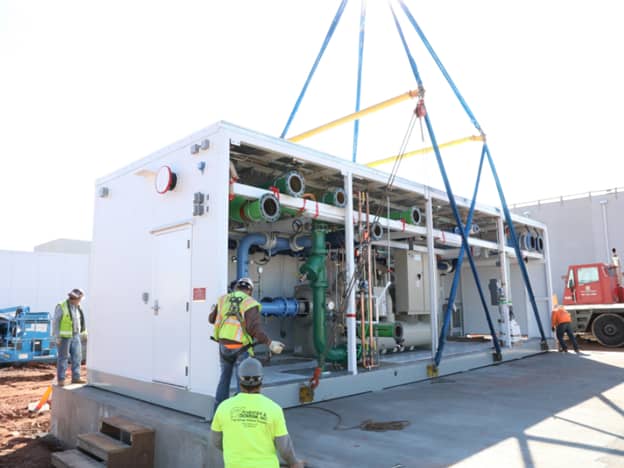
Modular construction is becoming more common in all types of builds, but it has amplified value when creating mechanical rooms and central utility plants (CUPs.) Off-site manufacturers can offer predictable schedules, cost certainty, and a steady stream of high-quality results.
Sometimes referred to as prefabrication or modular construction, off-site construction is attracting more attention and investment from a growing group of architects, engineers, contractors, and owners.
EAS Explains the Appeal of Off-Site Construction for CUPs
EAS is a North American manufacturer of custom-built HVAC solutions that specializes in highly engineered modular off-site constructed central utility plants, penthouses, and mechanical rooms. “Off-site construction is a hot topic today, but our company has been doing it for over twenty-five years,” says Bill Bullock, the Vice President of MEP Engineered Solutions at EAS.
“Schedule is one of the biggest reasons to use off-site construction,” Bullock notes. “EAS can reduce CUP construction timelines by using parallel processes. We time our construction in parallel with what’s happening at the job site, which cuts time from the schedule. EAS also builds CUPs in a manufacturing environment, eliminating many of the inefficiencies of a conventional construction site.
Fewer People on the Build Site
Engineers, architects, contractors, and owners agree that incorporating modular CUPs into a build creates considerable efficiencies. It removes manpower from the job site, reducing congestion and improving safety and quality.
Off-site construction can increase efficiencies for the contractors on the site. “When construction workers start their day,” Bullock explains. “A lot of time is lost due to inefficiencies, such as remote parking, material handling, travel or movement, congestion, etc. So, reducing overcrowding on site makes it easier to stay on schedule and get work done efficiently.”
Highly Skilled Experts Ready to Work
Securing the array of highly specialized trade contractors needed for building CUPs can also be a challenge. “Most highly skilled specialty contractors are located in large urban areas,” says Bullock. ”If your project is outside of those areas, there could be a real shortage of skilled labor, and it’s hard to find specialty contractors who can travel to your town or city to work on your project site.”
EAS employs a range of specialty trades and often provides additional training programs. “At EAS, we have a consistent labor pool, ready to go, in our plants,” Bullock reports. “Our employees are highly skilled and often do the same job every day, so they’re very efficient at what they do. Our labor productivity is two times what can be achieved on a construction site.”
Clean, Controlled Building Environment
Extreme heat, cold, snow, ice, rain, or even wind can slow down a worksite. Weather can also present safety hazards such as slick surfaces, wet equipment, or frostbite. But EAS employees build indoors, so weather isn’t a factor.
“Our teams work in dry, well-lit conditions, safe from weather extremes,” notes Bullock. “We are able to work faster and more efficiently because we are in an indoor conditioned manufacturing environment. This also provides a safer place to work.”
Manufacturing indoors also allows the EAS team to deliver CUPs that are clean and new. “If you’re building or even storing components of a new build on a project site, it’s going to get muddy and dusty by the end of the project,” says Bullock. “But when EAS ships a CUP, it’s wrapped and cleaned spotless. It’s like getting a new appliance.”
Cost Considerations of Off-Site Construction for CUPs
Although off-site doesn’t always represent a big saving in initial estimates, over the course of a project, off-site construction is often the more cost-efficient option. “EAS saves money during the process,” says Bullock. “EAS can provide cost certainty, so the customer avoids change orders. Many customers know that it is common for trade contractors to add about ten percent to the final cost to cover site issues that require more time or work. By the end of the job, GCs often pay more for on-site contractors because of weather delays, scheduling issues, or change orders.”
Plan to Use Modular Construction
While off-site construction provides a range of efficiencies, it does not happen by accident. In order for projects to achieve the highest value from utilizing off-site construction if must be designed into the project from the beginning. Project teams who bring on board a modular integrator to help design targeted aspects of the project upfront can save significant time and money as this allows for a parallel design and coordination process earlier in the project.
“When teams engage us early, we can design for manufacturing its fully coordinated,” says Bullock. “EAS takes information provided by the engineer of record and creates a design that matches the required performance and process. We design to a target value.”
EAS can often save months in the design phase. “Instead of soliciting rounds of bids to dozens of subcontractors, finding you’re over budget, redesigning with value engineering, re-bidding, negotiating, and then starting the coordination process with all the subcontractors,” Bullock explains, “we erase those steps by providing a fully coordinated design at a targeted budget. This saves months off the schedule.”
Want to Learn More About EAS?
Life Science Modular (LSM) can help you make EAS a part of your next project. Contact us today to get more details.